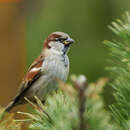en
names in breadcrumbs


A medium-sized (6 inches) Old World sparrow, the male House Sparrow is most easily identified by its mottled brown back, gray belly and crown, black “bib,” white cheeks, and chestnut head patches. Females are mottled gray-brown overall with a faint pale eye stripe. This species may be confused with a several other brownish species of Old World sparrows, but is almost unmistakable in areas where it occurs alone. House Sparrows are unrelated to similarly-patterned New World “sparrows,” which are in the same family as the Old-World buntings. The House Sparrow is native to Europe, North Africa, and parts of West and South Asia. Today, this species inhabits almost every temperate and subtropical locality on earth as a result of introductions by humans. Notable releases include that of around one hundred birds in Brooklyn, NY in the early 1850s, after which began the House Sparrow’s colonization of the United States and southern Canada. Other non-native populations exist in southern South America, South Africa, Australasia, and on oceanic islands around the world. Some House Sparrows in Central Asia migrate short distances south during the winter, while native and non-native populations elsewhere are non-migratory. House Sparrows inhabit an extraordinary variety of habitats around the world, including subtropical forests, dry deserts, temperate forests, and grasslands. This species is particularly successful at utilizing human-altered environments, and is found in high concentrations in agricultural and urban areas where food and man-made nesting sites are plentiful. House Sparrows primarily eat seeds and grains, including important cereal crops, although this species will also eat insects during the summer. In temperate and subtropical parts of the world, the House Sparrow is often one of the most visible bird species, particularly in urban areas. House Sparrows may be observed foraging for food in fields, hedgerows, parks, and even on bare sidewalk. This species is a cavity nester, and, as its name suggests, is particularly attracted to nesting in the eaves of buildings. House Sparrows are primarily active during the day.